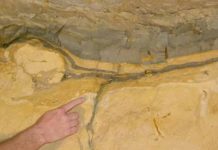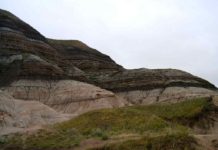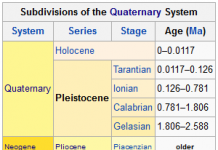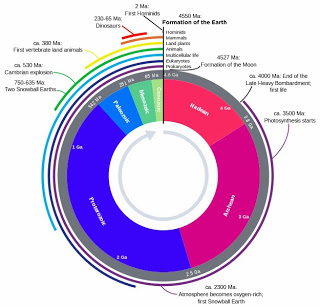
The Paleozoic (or Palaeozoic) Era is the earliest of three geologic eras of the Phanerozoic Eon, spanning from roughly 541 to 252.2 million years ago (ICS, 2004). It is the longest of the Phanerozoic eras, and is subdivided into six geologic periods (from oldest to least old): the Cambrian, Ordovician, Silurian, Devonian, Carboniferous, and Permian. The Paleozoic comes after the Neoproterozoic Era of the Proterozoic Eon, and is followed by the Mesozoic Era.
The Paleozoic was a time of dramatic geological, climatic, and evolutionary change. The Cambrian Period witnessed the most rapid and widespread diversification of life in Earth’s history, known as the Cambrian explosion, in which most modern phyla first appeared. Fish, arthropods, amphibians and reptiles all evolved during the Paleozoic. Life began in the ocean but eventually transitioned onto land, and by the late Paleozoic, it was dominated by various forms of organisms. Great forests of primitive plants covered the continents, many of which formed the coal beds of Europe and eastern North America. Towards the end of the era, large, sophisticated reptiles were dominant and the first modern plants (conifers) appeared.
The Paleozoic Era ended with the largest mass extinction in Earth’s history, the Permian–Triassic extinction event. The effects of this catastrophe were so devastating that it took life on land 30 million years into the Mesozoic to recover. Recovery of life in the sea may have been much faster.
Geology
In North America, the era began with deep sedimentary basins along the eastern, southeastern, and western sides of the continent, while the interior was dry land. As the era proceeded, the marginal seas periodically washed over the stable interior, leaving sedimentary deposits to mark their incursions. During the early part of the era, the area of exposed Precambrian, or shield, rocks in central Canada were eroding, supplying sediment to the basins from the interior. Beginning in the Ordovician Period, mountain building intermittently proceeded in the eastern part of the Appalachian region throughout the rest of the era, bringing in new sediments. Sediments washing from the Acadian Mountains filled the western part of the Appalachian basins to form the famous coal swamps of the Carboniferous Period. In North America carboniferous is not generally used instead the time is divided between Mississippian and Pennsylvanian period because of differences in the sedimentary rock deposited in this time. The Mississippian is characterized by limey sediments deposited in shallow seas, typically with abundant crinoidal fossils as in the Burlington fm. The Pennsylvanian typically is characterized by terrestrial sediments such as sands, shale and most importantly coal. Most of our oil and gas are obtained from Pennsylvanian sediments. Where this has been stripped, as in the Ozark domal region, oil is not typically available.
Paleoclimatic studies and evidence of glaciers indicate that central Africa was most likely in the polar regions during the early Paleozoic. During the early Paleozoic, the huge continent Gondwanaland had either formed or was forming. By mid-Paleozoic, the collision of North America and Europe produced the Acadian-Caledonian uplifts, and a subduction plate uplifted eastern Australia. By the late Paleozoic, continental collisions formed the supercontinent Pangaea and resulted in some of the great mountain chains, including the Appalachians, Urals, and mountains of Tasmania.
Tectonic activity
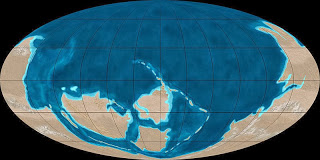
Geologically, the Paleozoic starts shortly after the breakup of a supercontinent called Pannotia. Throughout the early Paleozoic, the Earth’s landmass was broken up into a substantial number of continents. Towards the end of the era, the continents gathered together into a supercontinent called Pangaea, which included most of the Earth’s land area.
Climate
The middle Paleozoic was a time of considerable stability. Sea levels had dropped coincident with the ice age, but slowly recovered over the course of the Silurian and Devonian. The slow merger of Baltica and Laurentia, and the northward movement of bits and pieces of Gondwana created numerous new regions of relatively warm, shallow sea floor. As plants took hold on the continental margins, oxygen levels increased and carbon dioxide dropped, although much less dramatically. The north–south temperature gradient also seems to have moderated, or metazoan life simply became hardier, or both. At any event, the far southern continental margins of Antarctica and West Gondwana became increasingly less barren. The Devonian ended with a series of turnover pulses which killed off much of Middle Paleozoic vertebrate life, without noticeably reducing species diversity overall.
The late Paleozoic was a time which has left us a good many unanswered questions. The Mississippian began with a spike in atmospheric oxygen, while carbon dioxide plummeted to unheard-of lows. This destabilized the climate and led to one, and perhaps two, ice ages during the Carboniferous. These were far more severe than the brief Late Ordovician Ice; but, this time, the effects on world biota were inconsequential. By the Cisuralian, both oxygen and carbon dioxide had recovered to more normal levels. On the other hand, the assembly of Pangaea created huge arid inland areas subject to temperature extremes. The Lopingian is associated with falling sea levels, increased carbon dioxide and general climatic deterioration, culminating in the devastation of the Permian extinction.
Flora
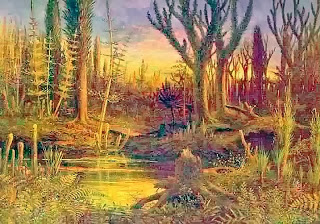
While macroscopic plant life appeared early in the Paleozoic and possibly late in the Neoproterozoic, it mostly remained aquatic until sometime in the Silurian and Devonian, when it began to transition onto dry land. Terrestrial flora reached its climax in the Carboniferous, when towering lycopsid rainforests dominated the tropical belt of Euramerica. Climate change caused the Carboniferous Rainforest Collapse which fragmented this habitat, diminishing the diversity of plant life in the late Carboniferous and Permian.


